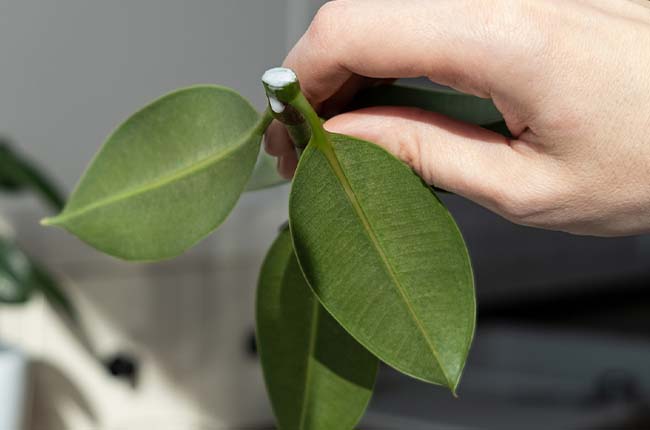Some of the houseplants and the plants in the garden could be a danger you were not aware of. These plants release a milky sap that can be toxic to touch when you prune them or break a stem by accident.
Are all plants with milky sap poisonous? Should you be worried?
Plants that produce highly toxic milky sap are mostly from the Euphorbia family. They can cause intense skin and eye inflammation, even blindness. Plants from non-Euphorbia families release sap that rarely triggers much, or only very mild skin irritation, and can thus be kept and used for their nutritional, medicinal, and ornamental value.
Of the thousands of plants with milky sap, we picked 20 species of shrubs, trees, succulents, and flowers that are most commonly kept as houseplants and seen in the garden.
Be sure to check out the different toxicity levels each plant can have, which ones to avoid, and which to keep for their amazing benefits.
The level of toxicity and the amount of sap produced varies from species to species.
In general, species from the Euphorbia or Spurge family produce a highly toxic milky sap. It contains a chemical called “ingenane diterpenoids” which is considered tumor-promoting and can create intense eye and skin inflammation when in contact.
Here’s a quick summary:
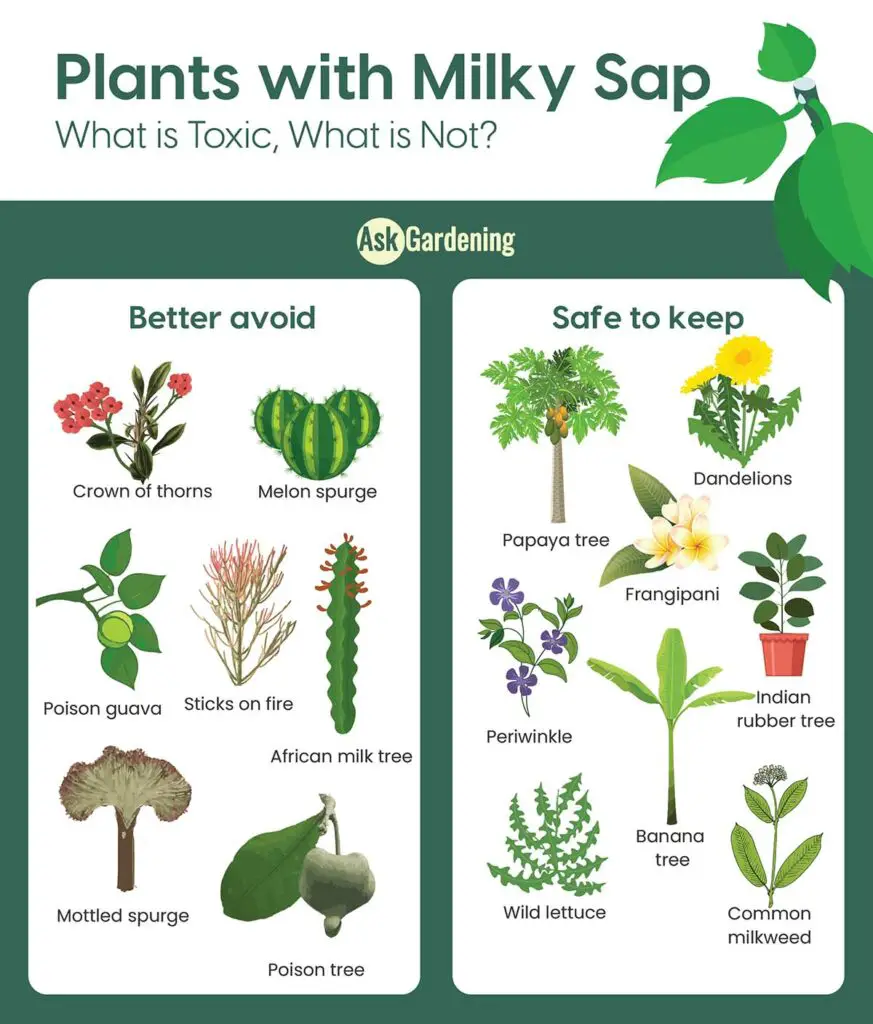
Are all plants with white sap toxic?
Even though some Euphorbia species are sold as garden plants and houseplants in nurseries, it is not recommended to keep them at home or in the garden, especially for those with children and pets.
Below is a table of the commonly available species that you should avoid. As you can see, the plants that are highly toxic and would cause intense reactions are mostly Euphorbias.
| Plants to avoid | Plant family |
| Crown of thorns | Euphorbia |
| Melon spurge | Euphorbia |
| Sticks on fire | Euphorbia |
| African milk tree | Euphorbia |
| Mottled spurge | Euphorbia |
| Poison guava | Euphorbia |
| Poison tree | Euphorbia |
| Garden croton | Euphorbia |
| Jatropha | Euphorbia |
| Raw cassava | Euphorbia |
Species from other plant families, such as Daisy, Dogbane, and Mulberry, release a latex that would not trigger much, or very light, irritation to the skin. These plants are safe for your home and garden.
| Plants safe to keep | Plant family |
| Indian rubber tree | Mulberry |
| Dandelions | Daisy |
| Periwinkle | Dogbane |
| Frangipani | Dogbane |
| Papaya tree | Caricaceae |
| Banana tree | Musaceae |
| Wild lettuce | Daisy |
| Common milkweed | Milkweed |
| Natal plum | Dogbane |
| Golden trumpet | Dogbane |
In the next section, we will go into detail about the toxicity of each of these plants.
Which plants produce milky sap?
Plants that produce milky sap mostly come from the Spurge or Euphorbia family (Euphorbiaceae), Dogbane family (Apocynaceae), Milkweed family (Asclepiadaceae), some also from the Daisy family (Asteraceae), and Mulberry family (Moraceae).
And they can be trees, shrubs, succulents, and herbaceous plants.
Herbaceous plants with latex
1. Dandelions
Dandelions (Taraxacum offiniale) are from the Daisy family.
It releases milky sap in its stems when broken.
Dandelions are considered a super herb with many health benefits. Its leaves can stimulate appetite and help with digestion. Its flowers have antioxidant properties, and its roots are used by herbalists to detoxify the liver.

Dcrjsr, CC BY 4.0, via Wikimedia Commons
2. Periwinkle
Periwinkle (Vinca) comes from the Dogbane family and is native to Southern and Central Europe.
Both “Large periwinkle” (Vinca major) and its variant “Lesser periwinkle” (Vinca minor) are herbaceous plants with large blue or lilac-colored flowers and glossy foliage.
Its stems produce latex when snapped but rarely cause a severe toxic reaction when touched and is thus safe to keep in the garden.
But it is commonly grown as an ornamental ground cover in temperate gardens for its evergreen foliage and its ability to form dense colonies with pretty blue flowers. It can grow up to 12 inches (30 cm) when exposed to direct sunlight.
It also has numerous medicinal uses, such as treating mouth ulcers, vaginal discharge, sore throat, and nose bleeding.
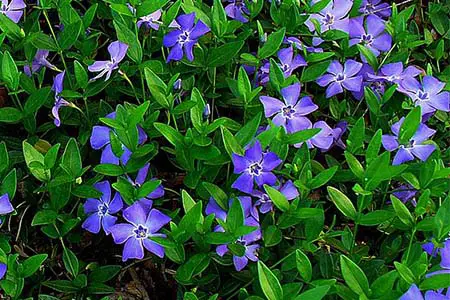
H. Zell, CC BY-SA 3.0, via Wikimedia Commons
3. Common milkweed
“Common milkweed” (Asclepias syriaca) comes from the Milkweed family.
This plant is a common weed in yards and gardens. It bears pink or somewhat purple flowers with an attractive scent and is able to colonize a bare, vacant area, in croplands, ditches, old fields, and roadsides.
It produces a highly poisonous milky sap in its stems and leaves when crushed. It can cause skin inflammation when touched. When ingested, it can cause nausea, diarrhea, confusion in small amounts, changes to heart rhythm, seizures, a stop in breathing, and even death in large amounts.
This plant should be removed from your living space.

by myself, in Lac-Mégantic, Quebec, CC-BY-SA-2.0-CA, via Wikimedia Commons
4. Wild lettuce
“Wild lettuce” (Lactuca Virosa) is a tropical plant from the Daisy family. When scratched, the plant produces milky sap called lactucarium.
This plant is not toxic. In fact, its milky sap is medicinal and is a healthy alternative to opium in creating a relaxing, soothing sensation. The sap is collected for treating restlessness, insomnia, urinary tract problems, cough, and joint pains.
In addition, wild lettuce can be eaten raw or cooked like a vegetable.
This is definitely a keeper if you see it in your garden.
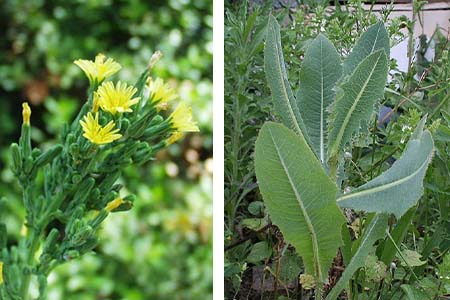
Luis Nunes Alberto, CC BY 3.0, via Wikimedia Commons
H. Brisse (upload by Abalg), CC BY-SA 3.0, via Wikimedia Commons
Succulents and cacti with latex
5. Melon spurge
“Melon spurge” (Euphorbia meloformis) is a dwarf succulent from the Spurge family.
It’s shaped like an apple and can grow up to 4.8 inches (12 cm) in diameter and have 8 to 12 ribs.
Its milky sap is toxic and should be avoided as a houseplant.
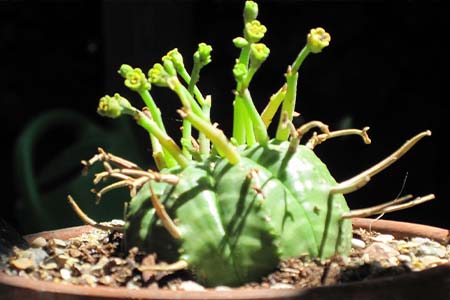
Petar43, CC BY-SA 3.0, via Wikimedia Commons
6. African milk tree
“African milk tree” (Euphorbia trigona), also called “high chaparral” or “cathedral cactus”, is a perennial cactus from the Euphorbia family.
It has one tall central trunk and a couple of arms pointing upwards. It produces a smelly and highly poisonous milky sap, which can also cause intense inflammation of the skin and eye and even temporary blindness.
It is often grown in the garden or roadsides as a natural fence or hedge due to its rapid, vigorous growth. But it should be avoided near your living space.
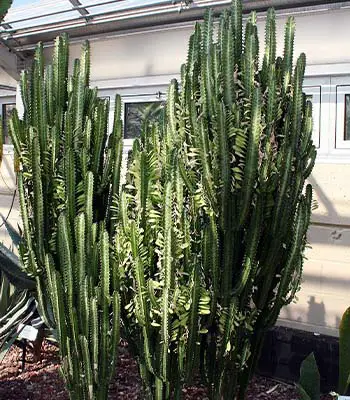
Photo by David J. Stang, CC BY-SA 4.0, via Wikimedia Commons
7. Mottled spurge
Mottled spurge (Euphorbia Lactea) is an evergreen cactus-like shrub from the Euphorbia family.
Its milky sap irritates the eyes and skin.
The plant is often grown as a natural fence or hedge to keep away intruders because of the spines along its edges, and because it can grow rapidly up to 15 feet (5 meters). It is also a popular choice as a houseplant for its unique appearance.
However, its sap is so poisonous that some indigenous tribes apply it on arrow tips for hunting. It should thus be avoided near any living space.
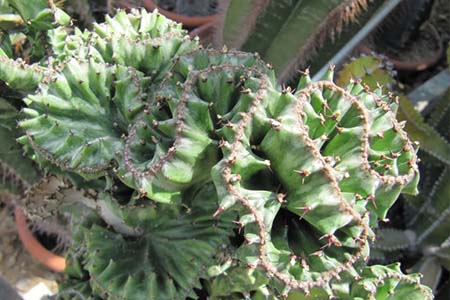
Leonora Enking from West Sussex, England, CC BY-SA 2.0, via Wikimedia Commons
8. Poison tree
“Poison tree” or “Gifboom” (Euphorbia virosa) is the most poisonous species from the Euphorbia family. It is a large thorny cactus with branches.
The highly toxic white sap is carcinogenic and can cause severe blistering if touched and blindness when coming into contact with the eye. It is used as an arrow poison by Bushmen during hunting.
It is not recommended to grow this plant as a houseplant, although some nurseries do sell this.
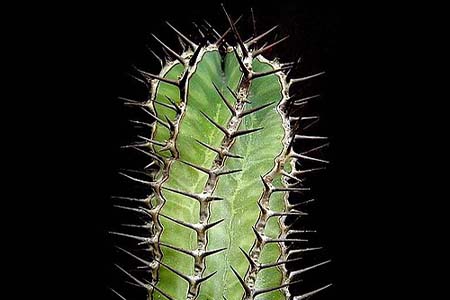
Frank Vincentz, CC BY-SA 3.0, via Wikimedia Commons
9. Sticks on fire
“Sticks on fire” (Euphorbia tirucalli) is a succulent, spineless shrub with pencil-like green branches. It is from the Euphorbia family and mainly grows in hot climates.
It is known as “sticks on fire” because of the burning sensation it can create when coming into contact with its sap. It is also known as “finger tree” or “pencil tree” because of the shape of its leaves.
This plant splashes out a milky sap that does not wash off easily with water when a leaf is plucked or when its stem is cut. The sap is highly irritating to the skin and eyes that would require urgent care immediately.
Even though the plant is medicinal with applications in treating asthma, cancer, warts, etc., and can even be used to produce biofuel, it is not an appropriate ornamental plant for the garden.

Mokkie, CC BY-SA 3.0, via Wikimedia Commons
Shrub with latex
10. Crown of thorns
“Crown of thorns” (Euphorbia milii) is from the Euphorbia family.
It has intense reddish-pink flowers and thorny stems. Its sap can cause intense inflammation to the skin and eye and should not be kept as a houseplant or in the garden, despite its popularity as a houseplant.
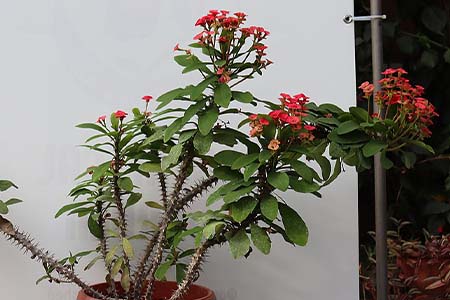
Dandarmkd, CC BY-SA 4.0, via Wikimedia Commons
11. Cassava
“Cassava” (Manihot Esculenta) is a perennial woody shrub from the Euphorbia family native to South America.
Its large tubular-shaped root oozes milky sap when cut, which is highly toxic when consumed raw. Its milky sap contains cyanide and can lead to poisoning.
But it can be removed by a lot of cooking preparations, such as boiling and roasting for hours. In Africa and Southeast Asia, the cassava root is one of the major staple food and source of dietary carbohydrates, surpassed only by rice and maize.
Cassava is also medicinal such as treating tiredness, sepsis, diarrhea, and inducing labor.
It is not dangerous to touch and since the poison can be removed by cooking, it is not a plant that you should avoid.
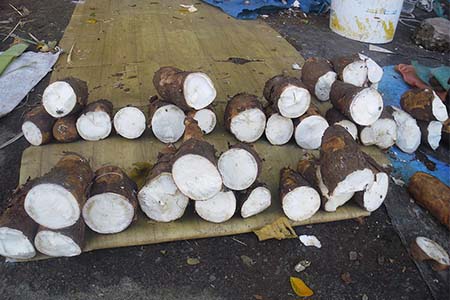
Surya Prakash.S.A., CC BY-SA 3.0, via Wikimedia Commons
12. Golden Trumpet
“Golden Trumpet” (Allamanda cathartica) is a shrub from the Dogbane family.
The evergreen plant has large attractive yellow flowers 5 inches (13 cm) in diameter.
There is no need to avoid this plant as its sap is only mildly toxic causing some irritation to the skin and eyes.
13. Garden croton
“Garden croton” (Codiaeum Variegatum) is an evergreen flowering perennial in the Euphorbia family, native to the tropical regions of Malaysia.
The white milky sap found in the plant’s leaves, roots, and stems can cause skin irritation, also known as contact dermatitis.
But, it is commonly used as a decorative indoor plant for its colorful red and green foliage. It is also used by indigenous populations for the treatment of diarrhea, stomach pain, external wounds, and ulcers.
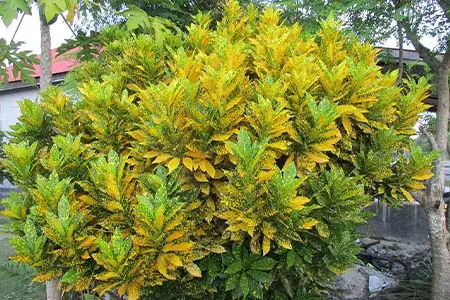
David E Mead, CC0, via Wikimedia Commons
14. Jatropha
“Jatropha” (Jatropha Curcas) is a flowering shrub in the Euphorbia family, native to tropical Africa.
It has fleshy stems and emits a toxic milky sap when cut, and will cause severe issues like upset stomach and diarrhea if taken in large amounts.
Despite its medicinal properties in treating fungal infections and its potential in producing biodiesel, it is not a good choice as an ornamental plant in the garden.
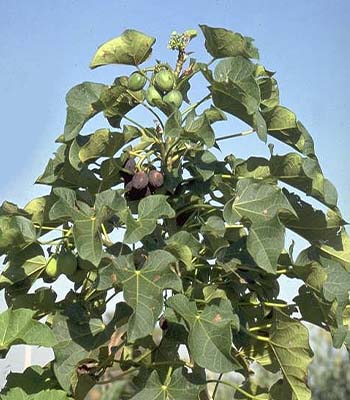
Trees with latex
15. Indian rubber tree
“Indian rubber tree” (Ficus elastica) is from the Mulberry family.
All Ficus species, including the fig tree (Ficus carica), produce a white sap when its stem or fruits are picked. The sap is slightly sticky and may cause mild skin irritation. When you eat a fresh fig fruit with sap residue, you may experience slight irritation in your throat but nothing more than that. It is definitely safe to keep it as a houseplant.
The rubber tree and Ficus species are mostly valued for their edible fruits (fig), and their ornamental value as houseplants. Its sap can also be used to create natural rubber, which is an essential raw material for creating many rubber products such as medical devices, gloves, aircraft and car tires, pacifiers, clothes, toys, etc.
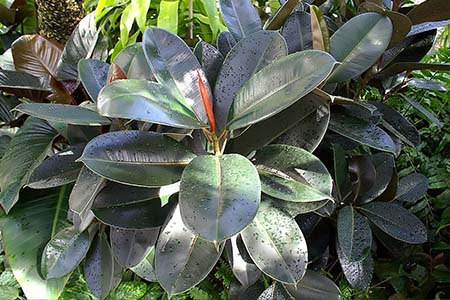
David J. Stang, CC BY-SA 4.0, via Wikimedia Commons
16. Frangipani
“Frangipani” (Plumeria) is a deciduous tree from the Dogbane family.
When its bark is cut, it drips a white milky sap that is irritative to the skin and eyes, and is mildly toxic that will cause diarrhea and vomiting when ingested.
However, it is often used as an ornamental tree on the roadsides in tropical and warm temperate areas for its pretty five-petaled flowers with a gorgeous sweet perfume.
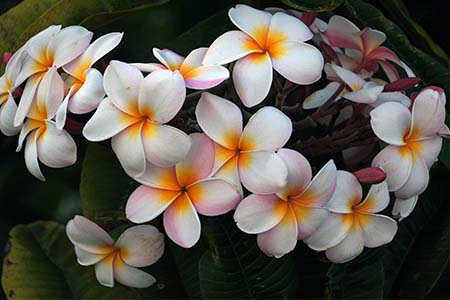
Bernard Spragg. NZ from Christchurch, New Zealand, CC0, via Wikimedia Commons
17. Papaya
Papaya (Carica papaya) is among the few edible species of the Carica genus. Unripe papaya releases milky white latex when cut. The sap can cause irritation for some people but its uses are numerous in making chewing gums, toothpaste, facial creams, and meat tenderizer. Ripe papaya is also a valued fruit for its sweet taste.
18. Banana tree
The banana tree (Plantain) is a member of the Musaceae family.
Its milky sap is somewhat sticky but is not toxic and can actually be used externally for stings and bites, to stop a bleeding wound, to reduce hair loss, and promote hair growth.
Banana trees are most recognized for their fruit, which is delicious and a rich source of carbohydrates and potassium. It is also a natural cure for diarrhea and constipation.
Its fibrous stems can be used to fabricate rope, placemats, tea bags, high-quality textiles, absorbents, etc.
19. Natal plum
The natal plum (Carissa macrocarpa) is an evergreen shrub from the Dogbane family. Its milky sap is mildly toxic. But the plant is highly valued for the high nutritional value of its plump, crimson fruits which can be eaten raw or cooked in jam.

SAplants, CC BY-SA 4.0, via Wikimedia Commons
20. Poison guava
Poison guava (Hippomane mancinella) belongs to the Spurge (Euphorbiaceae) family and is native to North and South America.
It is seen as one of the most poisonous trees on earth. The milky sap found in all of the plant’s parts can cause intense skin irritation and will result in painful blisters.
Nevertheless, it is valued for its timber and is occasionally used as a medicine.
What is the white juice coming out of a plant?
Thousands of plant species release a milky white liquid called latex when cut or crushed.
The content of latex is typically a mixture of oils, gums, resins, proteins, starches, sugars, tannins, and alkaloids which give it a high pH.
Why do plants produce milky sap?
It is the plant’s self-defense mechanism to release a milky sap that is bitter, and foul-smelling. It is unappealing or even deadly for predators that try to eat them.
That is why Euphorbias and many plants with highly toxic sap originate in the deserts of Africa where food is scarce. It is similar to plants with developed thorns.
Another reason for plants to produce milky sap is to heal injured parts faster. When the plant tissues are broken, the plant releases latex that hardens quickly and seals the wound, thereby preventing infection or fluid loss.
How poisonous is latex?
The more toxic the milky sap is, the more alkaline it is, reaching up to pH 10. It is also sticky and difficult to wash off with water and even soap.
The latex from the highly toxic species of Euphorbias can come splashing out when you trim it or accidentally break a stem, landing on your skin or even your eye. Even if it lands on your hair or your fingers and you rub your eye or wash your hair, the sap could enter your eye.
There are many documented cases of people with “excruciating pain” in the eye after coming into contact with the latex from Euphorbias by accident or even without knowing it exists in the garden (McVeigh, 2018). The burning sensation is described as “acid splashed to the eyes”.
You would need somebody to take you to urgent care to flush your eye. If it goes well, the stinging would disappear only the day after.
One case has even resulted in a cornea transplant surgery (Dutta et al., 2012).
Because of these toxic properties, these plants are often used as fencing to keep out intruders. Its highly alkaline property is also used in various ways, especially in ancient cultures, e.g. as caustic to treat tumors.
But for home gardeners, Euphorbias should be kept at bay.
Conclusion
The level of toxicity and irritation of the milky sap varies depending on the species.
In general, the sap produced by Euphorbias is highly toxic that can create intense reactions for the skin and eye and even blindness if not treated properly. They should therefore not be kept as houseplants even though they are sold in some nurseries.
Plants from other non-Euphorbia families are less toxic and rarely cause intense inflammatory reactions with their sap and can be kept as houseplants. But if you are not sure, wear gloves and protective eyewear when handling plants with white sap.
Happy gardening!
Related
14 Fragrant Succulents & Cacti (You Will Love)
Is My Succulent Having A “Death Bloom”? What To Do?
References
Blum, U. (1986). Plants defend themselves chemically. In Research for Tomorrow, 1986 Yearbook of Agriculture (pp. 139-142). US Department of Agriculture, Washington, DC, USA.
Dutta, J., Mukhopadhyay, S., Datta, H. & Sen, S. (2012). Boston keratoprosthesis restoring vision in an unusual case of end-stage limbal stem cell deficiency following exposure to Euphorbia latex. Int Ophthalmol. Vol 32 (1), pp. 77–79.
Falade, K. O., & Akingbala, J. O. (2010). Utilization of cassava for food. Food Reviews International, 27(1), 51-83.
Konno, K. (2011). Plant latex and other exudates as plant defense systems: Roles of various defense chemicals and proteins contained therein. Phytochemistry, Vol 72 (13), Pp. 1510-1530. https://doi.org/10.1016/j.phytochem.2011.02.016.
McVeigh, K. (2018). Ubiquitous euphorbia is anything but euphoria for the eye: a reminder to get any area of contact with the toxic sap under the tap. Eye 32, 243–247.
Muscat, M. K. M. (2019). Manchineel Apple of Death. EJIFCC, 30(3), 346-348. https://europepmc.org/article/med/31695591
Mwine, J., & Van Damme, P. (2011). Euphorbia tirucalli L.(Euphorbiaceae) The miracle tree: Current status of available knowledge. Scientific Research and Essays, 6(23), 4905-4914.
Pantoja, A., Follett, P. A., & Villanueva-Jiménez, J. A. (2002). Pests of papaya. Tropical fruit pests and pollinators: Biology, economic importance, natural enemies and control. Cambridge, CABI Publishing, 448p, 131-156.
- Top 6 Drip Irrigation Systems for Raised Beds (2025) - January 31, 2025
- Top 10 Orchid Fertilizers: A Comprehensive Review (2025) - January 16, 2025
- Top 6 Slow-Release Fertilizers for Houseplants & Veggies (2025) - January 15, 2025

